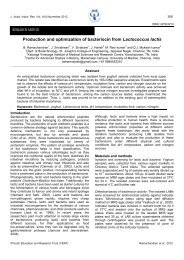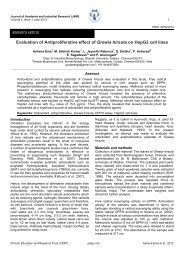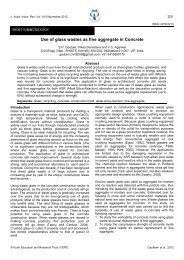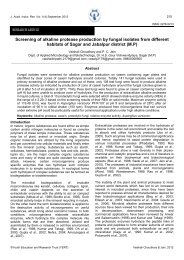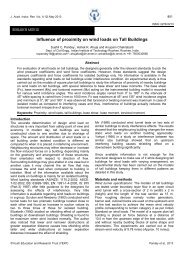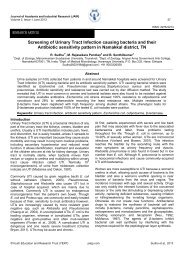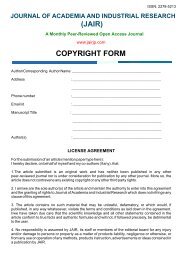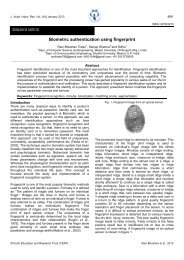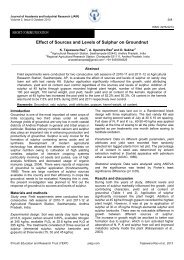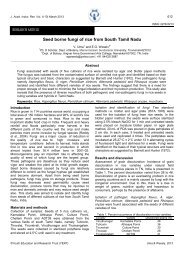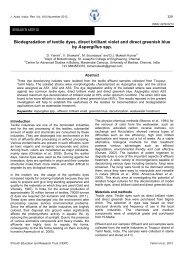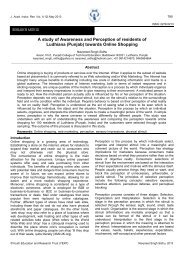Isolation of bacteriocin nisin producing Lactococcus lactis from dairy ...
Isolation of bacteriocin nisin producing Lactococcus lactis from dairy ...
Isolation of bacteriocin nisin producing Lactococcus lactis from dairy ...
Create successful ePaper yourself
Turn your PDF publications into a flip-book with our unique Google optimized e-Paper software.
J. Acad. Indus. Res. Vol. 1(10) March 2013 630This indicated that crude <strong>bacteriocin</strong> produced byL. <strong>lactis</strong> was heat stable at 100C. The hypothesis <strong>of</strong> thisstudy was to demonstrate that the optimum temperaturefor cell growth should be the optimum for <strong>bacteriocin</strong>production as well. Therefore, the <strong>bacteriocin</strong> productionwas conducted at 37C. E. coli was least sensitive toinhibitory substance produced by LAB as compared toother indicator strain. The resistance <strong>of</strong> gram-negativebacteria is attributed to the particular nature <strong>of</strong> their cellenvelop, the mechanism <strong>of</strong> action described for<strong>bacteriocin</strong>. This could be due to fact that these isolatesare <strong>nisin</strong> producers (Soomro et al., 2002) and theprimary target <strong>of</strong> <strong>nisin</strong> antimicrobial action is the cellmembranes. Nisin has a inhibitory effect against a widevariety <strong>of</strong> gram-positive food borne pathogens andspoilage microorganisms (Rodriguez, 1996). In thisstudy, wider inhibition zone were observed by the<strong>Lactococcus</strong> on the test strains. Similarly, Kellyet al. (1996) and Hernandez et al. (2005) reported thatseveral Lactococci produced <strong>nisin</strong> like activity andshowed a broad inhibitory spectrum against the indicatorstrains tested.ConclusionThe culture filtrates <strong>from</strong> L. <strong>lactis</strong> isolated <strong>from</strong> <strong>dairy</strong>products exhibited antimicrobial activity against threeindicator test strains. The test isolate was grown in MRSmedium under optimized conditions. Bacteriocin activity<strong>of</strong> the test isolate was determined by agar well diffusionassay against Escherichia coli, Staphylococcus aureusand Bacillus sp. The optimum temperature <strong>of</strong> L. <strong>lactis</strong> inMRS medium was 37C. Highest viable cell count <strong>of</strong>L. <strong>lactis</strong> at 37C reached about 8.54 log cfu/mL in 8 h.Bacteriocin <strong>nisin</strong> production was maximized whenL. <strong>lactis</strong> was grown in controlled pH fermentation medium<strong>of</strong> 6.5. Bacteriocin supernatant <strong>of</strong> L. <strong>lactis</strong> was heatstable, as the inhibition activity remained constant afterheating at 80C for 20 min. The results revealed thatE. coli was least sensitive to crude <strong>bacteriocin</strong>supernatant <strong>of</strong> L. <strong>lactis</strong> as compared to other indicatorstrains.References1. Benkerroum, N., Oubel, H., Zahar, M., Dlia, S. andFilali-Maltouf, A. 2000. <strong>Isolation</strong> <strong>of</strong> a <strong>bacteriocin</strong><strong>producing</strong><strong>Lactococcus</strong> <strong>lactis</strong> subsp. <strong>lactis</strong> andapplication to control Listeria monocytogenes inMoroccan jben. J. Appl. Microbiol. 89(6): 960-968.2. Deegan, L.H., Cotter, P.D., Hill, C. and Ross, P. 2006.Bacteriocin: Biological tools for bio-preservation andshelf-life extension. Int. Dairy J. 16 (9): 1058-1071.3. Delves-Broughten, J. 1990. Nisin and its uses as a foodpreservative. Int. J. Food Technol. 43: 73-76.4. Franz, C.M., Du Toit, M., Schillinger, U. and Holzapfel,W.H. 1997. Production <strong>of</strong> <strong>nisin</strong>-like <strong>bacteriocin</strong>s by<strong>Lactococcus</strong> <strong>lactis</strong> strains isolated <strong>from</strong> vegetables. J.Basic. Microbiol. 37(3): 187-196.5. Girum, T., Ephraim, E. and Ashenafi, M. 2005.Assessment <strong>of</strong> the antimicrobial activity <strong>of</strong> lactic acidbacteria isolated <strong>from</strong> Borde and Shameta, traditionalEthiopian fermented beverages, on some food-bornepathogens and effect <strong>of</strong> growth medium on the inhibitoryactivity. Int. J. Food Safety. 5: 13-20.6. Hansen, J.N. and Liu, W. 1990. Some chemical andphysical properties <strong>of</strong> <strong>nisin</strong>, a small protein antibioticproduced by <strong>Lactococcus</strong> <strong>lactis</strong>. Appl. Environ.Microbiol. 12: 25-55.7. Hernandez, D., Cardell, E. and Zarate, V. 2005.Antimicrobial activity <strong>of</strong> lactic acid bacteria isolated <strong>from</strong>Tenerife cheese: Initial characterization <strong>of</strong> plantaricinTF711, a <strong>bacteriocin</strong>-like substance produced byLactobacillus plantarum TF711. J. Appl. Microbiol. 99(1):77-84.8. Jack, R.W., Tagg, J.R. and Ray, B. 1991. Bacteriocins <strong>of</strong>gram-positive bacteria. Microbiol. Rev. 59: 171-200.9. Kelly, W.J., Asmundson, R.V. and Huang, C.M. 1996.<strong>Isolation</strong> and characterization <strong>of</strong> <strong>bacteriocin</strong> <strong>producing</strong>lactic acid bacteria <strong>from</strong> ready to eat food products. Int.J. Food Microbiol. 33: 209-218.10. Matsusaki, H., Chinachoti, N., Sonomoto, K. andIshizaki, A. 1998. Purification, identification, and effectiveproduction <strong>of</strong> a peptide antibiotic produced by<strong>Lactococcus</strong> <strong>lactis</strong> OI-1 (JCM 7638). Annl. New YorkAcad. Sci. 864(1): 422–427.11. McAuliffe, O., Ross, R.P. and Hill, C. 2001. Antibiotics:Structure, biosynthesis and mode <strong>of</strong> action. FEMSMicrobiol. Rev. 25(3): 285-308.12. Mitra, S., Chakrabartty, P.K. and Biswas, S.R. 2005.Production and characterization <strong>of</strong> <strong>nisin</strong>-like peptideproduced by a strain <strong>of</strong> <strong>Lactococcus</strong> <strong>lactis</strong> isolated <strong>from</strong>fermented milk. Curr. Microbiol. 51: 183–187.13. O’keeffe, T. and Hill, C. 1999. Bacteriocins potential infood preservation. Encyclopedia <strong>of</strong> food Microbiology,Acad. press, New York. 1: 183-191.14. Olasupo, N.A., Schillinger, U., Narbad, A., Dodd, H. andHolzapfel, W.H. 1999. Occurrence <strong>of</strong> <strong>nisin</strong> Z productionin <strong>Lactococcus</strong> <strong>lactis</strong> BFE 1500 isolated <strong>from</strong> Wara, atraditional Nigerian cheese product. Int. J. FoodMicrobiol. 53: 141–153.15. Rodriguez, J.M. 1996. Antimicrobial spectrum, structure,properties and mode <strong>of</strong> action <strong>of</strong> <strong>nisin</strong>, a <strong>bacteriocin</strong>produced by <strong>Lactococcus</strong> <strong>lactis</strong>. Int. J. Food Sci.Technol. 2: 61-68.16. Soomro, A.H., Maud, T. and Anwaa, K. 2002. Role <strong>of</strong>lactic acid bacteria (LAB) in food preservation andhuman health-A review. Pak. J. Nutrition. 1(1): 20-24.17. Yang, R. and Ray, B. 1994. Factors influencingproduction <strong>of</strong> <strong>bacteriocin</strong>s by lactic acid bacteria. Food.Microbiol. 11(4): 281-291.18. Zendo, T., Fukao, M., Ueda, K., Higuchi, T., Nakayama,J. and Sonomoto, K. 2003. Identification <strong>of</strong> the antibiotic<strong>nisin</strong> Q, a new natural <strong>nisin</strong> variant produced by<strong>Lactococcus</strong> <strong>lactis</strong> isolated <strong>from</strong> a river in Japan. Biosci.Biotechnol. Biochem. 67: 1616-1619.©Youth Education and Research Trust (YERT) Nagalakshmi et al., 2013



